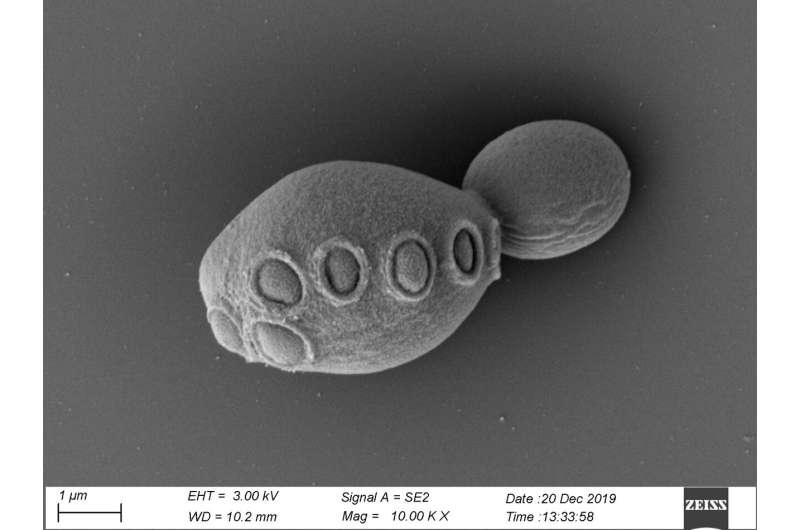This article has been reviewed according to Science X's editorial process and policies. Editors have highlighted the following attributes while ensuring the content's credibility:
fact-checked
peer-reviewed publication
trusted source
proofread
Yeast with more than 50% synthetic genome is created in the lab

Researchers have combined over seven synthetic chromosomes that were made in the lab into a single yeast cell, resulting in a strain with more than 50% synthetic DNA that survives and replicates similarly to wild yeast strains.
The team present the half-synthetic yeast November 8 in the journal Cell as part of a collection of papers across Cell, Molecular Cell, and Cell Genomics that showcase the Synthetic Yeast Genome Project (Sc2.0), a global consortium working to develop the first synthetic eukaryote genome from scratch. The team has now synthesized and debugged all sixteen yeast chromosomes.
"Our motivation is to understand the first principles of genome fundamentals by building synthetic genomes," says co-author and synthetic biologist Patrick Yizhi Cai of the University of Manchester, who is also senior author of two other papers in the collection. "The team has now re-written the operating system of the budding yeast, which opens up a new era of engineering biology—moving from tinkering a handful of genes to de novo design and construction of entire genomes."
Though bacterial and viral genomes have been synthesized previously, this would be the first synthetic eukaryote genome, which introduces the complication of multiple chromosomes. The synthetic yeast is also a "designer" genome that differs substantially from the natural Saccharomyces cerevisiae (brewer's or baker's yeast) genome on which it is based.
"We decided that it was important to produce something that was very heavily modified from nature's design," says senior author and Sc2.0 leader Jef Boeke, a synthetic biologist at NYU Langone Health. "Our overarching aim was to build a yeast that can teach us new biology."
To this end, the researchers removed chunks of non-coding DNA and repetitive elements that could be considered "junk," added new snippets of DNA to help them more easily distinguish between synthesized and native genes, and introduced a built-in diversity generator called "SCRaMbLE" that shuffles the order of genes within and between chromosomes.
To increase genome stability, the team also removed many of the genes that encode transfer RNA (tRNA) and relocated them to an entirely new "neochromosome" consisting only of tRNA genes. "The tRNA neochromosome is the world's first completely de novo synthetic chromosome," says Cai. "Nothing like this exists in nature."
Since the yeast genome is organized into 16 chromosomes, the researchers began by assembling each chromosome independently to create 16 partially synthetic yeast strains that each contained 15 natural chromosomes and one synthetic chromosome. The next challenge was to begin combining these synthetic chromosomes into a single yeast cell.
To do this, Boeke's team started by using a method reminiscent of Mendel's peas: essentially, the researchers interbred different partially synthetic yeast strains and then searched among their progeny for individuals carrying both synthetic chromosomes.
Though effective, this method is very slow, but the team gradually consolidated all previously synthesized chromosomes—six full chromosomes and one chromosome arm—into a single cell. The resulting yeast strain was more than 31% synthetic, had normal morphology, and showed only slight growth defects compared to wild-type yeast.
To more efficiently transfer specific chromosomes between yeast strains, the researchers developed a new method called chromosome substitution that is discussed in another paper in the new collection. As a proof of concept, they used chromosome substitution to transfer a newly synthesized chromosome (chromosome IV, the largest of all the synthetic chromosomes), resulting in a yeast cell with 7.5 synthetic chromosomes that is more than 50% synthetic.
When the synthetic chromosomes were consolidated into a single yeast strain, the team detected several genetic defects or "bugs" that were invisible in yeast strains that only carried one synthetic chromosome. "We knew in principle that this might happen—that we might have a huge number of things that had tiny little effects and that, when you put them all together, it might result in death by a thousand cuts," says Boeke.
Some of these bugs were simply due to the additive impact of having many tiny defects within the genome, while others involved genetic interactions between genes on the different synthetic chromosomes. The researchers were able to map and fix several of these bugs and increase the synthetic yeast's fitness by using a method based on CRISPR/Cas9.
"We've now shown that we can consolidate essentially half of the genome with good fitness, which suggests that this is not going to be a big problem," says Boeke. "And from debugging, we learn new twists on the rules of life."
The next step will be to integrate the remaining synthetic chromosomes. "Now we're just this far from the finish line of having all 16 chromosomes in a single cell," says Boeke. "I like to call this the end of the beginning, not the beginning of the end, because that's when we're really going to be able to start shuffling that deck and producing yeast that can do things that we've never seen before."
More information: Debugging and consolidating multiple synthetic chromosomes reveals combinatorial genetic interactions, Cell (2023). DOI: 10.1016/j.cell.2023.09.025. www.cell.com/cell/fulltext/S0092-8674(23)01079-6
Design, Construction, and Functional Characterization of a tRNA Neochromosome in Yeast, Cell (2023). DOI: 10.1016/j.cell.2023.10.015. www.cell.com/cell/fulltext/S0092-8674(23)01130-3
Dissecting aneuploidy phenotypes by constructing Sc2.0 chromosome VII and SCRaMbLEing synthetic disomic yeast, Cell Genomics (2023). DOI: 10.1016/j.xgen.2023.100364. www.cell.com/cell-genomics/ful … 2666-979X(23)00147-7
Consequences of a telomerase-related fitness defect and chromosome substitution technology in yeast synIX strains, Cell Genomics (2023). DOI: 10.1016/j.xgen.2023.100419. www.cell.com/cell-genomics/ful … 2666-979X(23)00245-8
Cell Genomics, Taghon et al., "Rise of synthetic yeast: Charting courses to new applications" DOI: 10.1016/j.xgen.2023.100438 , www.cell.com/cell-genomics/ful … 2666-979X(23)00273-2
Cell Genomics, Nicholson et al., "A spotlight on global collaboration in the Sc2.0 yeast consortium" DOI: 10.1016/j.xgen.2023.100438 , www.cell.com/cell-genomics/ful … 2666-979X(23)00276-8
Molecular Cell (2023). DOI: 10.1016/j.xgen.2023.100441
Journal information: Molecular Cell , Cell , Cell Genomics
Provided by Cell Press




















